Do you want to learn some bobcat facts for kids? We discuss many facts in this post. We’ll talk about their physical description, habitat, habits, predators, and more!

Physical Description
Bobcats range in color from brown to brownish-red with black spots or lines. Most bobcats have white bellies. Bobcat faces are broad and flat. A bobcat has long fur on the sides of its face and tufted ears. This medium-sized cat has long legs with large paws. Their tails have a black tip on top, but they are white underneath.
Bobcats are about twice the size of domestic cats. Male bobcats are larger than female bobcats. Bobcats range in weight from fourteen to forty pounds. A bobcat can grow to be eighteen to forty-nine inches long. Bobcat tails range from four to eight inches in length.
Habitat
Bobcats can be found from southern Canada to northern Mexico, including most US states. They are adaptable and live in a variety of habitats. Their habitat includes all types of woodlands as well as coastal swamps, mountains, and deserts.
Bobcats can live in snowy areas, but they prefer warmer climates. Bobcats have several dens in their habitat. The kind of den a bobcat has depends on what’s available in its environment. Bobcats make their dens in places like rock caves and hollow trees.
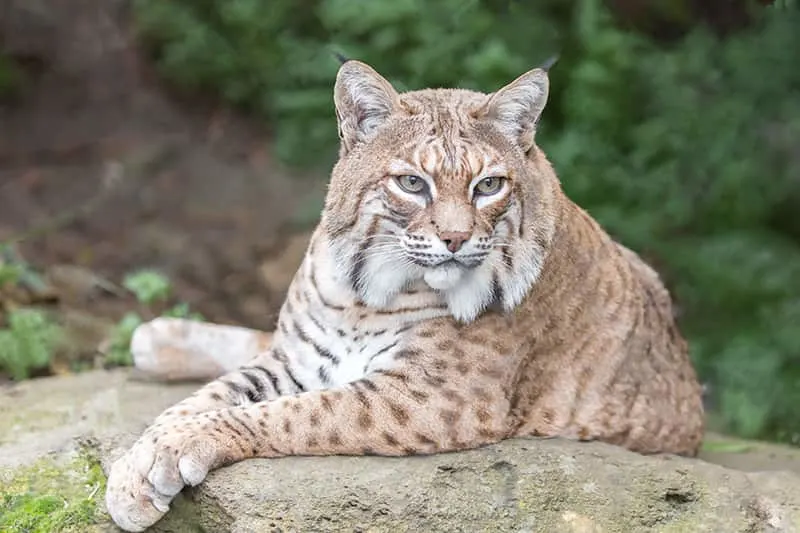
Habits
Bobcats are solitary and nocturnal creatures. They typically spend the day sleeping in their dens. They are most active at dawn and dusk. This is when they look for dens and hunt. They have several dens in their territory so they can hide from predators.
A male bobcat’s territory is about thirty square miles. At five square miles, the female bobcat’s territory is much smaller. Bobcats use urine to mark their territory. They aren’t migratory. They will only leave their territory in search of prey.
Bobcats are predators that stalk and ambush their prey. A bobcat does not always eat all its food at once. Bobcats will cover up their leftover prey so that they can return and eat it later.
Diet
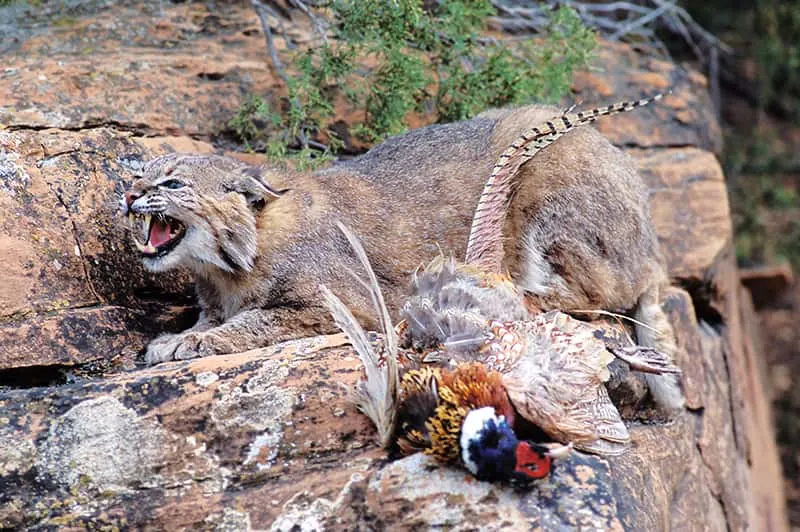
Bobcats are carnivores who prefer an all-meat diet. They eat about two pounds of meat a day. They will hunt and eat almost any animal.
Bobcats mainly eat rabbits, rats, and mice. They also eat ground-nesting birds such as turkeys. They eat small deer and fish as well. If a bobcat lives in an area with domestic animals, it will most likely kill and eat them. Bobcats are known to kill and eat livestock, pigs, and other domestic animals like cats.
Offspring
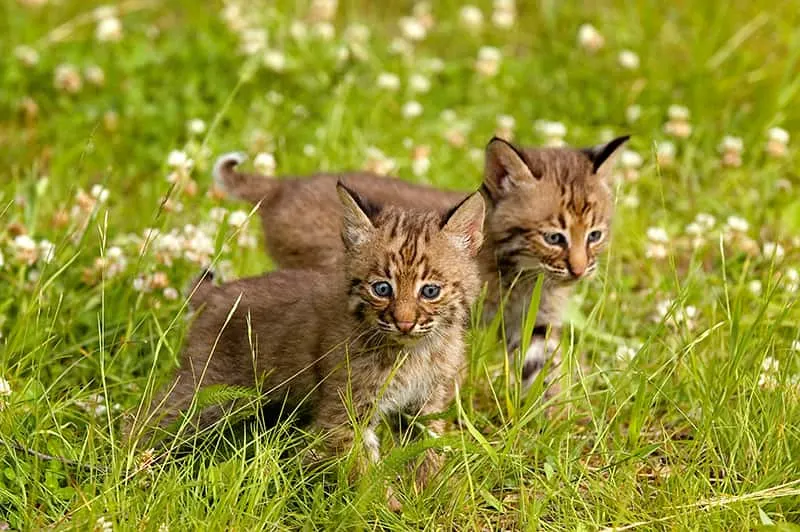
Bobcats typically mate once a year in the spring. Male bobcats will mate with more than one female in their territory. If a male can’t find a female in his territory, he will cross into another one. Bobcats never see each other again after mating.
Mother bobcats are pregnant for about sixty days. Bobcat mothers can have up to six kittens in a litter, but they usually have three. The kittens are about eight inches long and weigh about eight ounces when they are born. Bobcat kittens are born with closed eyes and have greyish-brown spotted fur. Bobcat kittens’ eyes open when they are about a week old. The eyes turn yellow by the time the kittens are two weeks old.
Bobcat kittens will nurse for about two months. They start crawling around one month old. When they begin to crawl, the bobcat mother begins to feed them meat in addition to milk. The mother starts teaching the kittens how to hunt when they are about nine months old. Juvenile bobcats will leave their mother and find their own territory when they are around a year old.
Classification/Taxonomy
Kingdom: Animalia
Phylum: Chordata
Class: Mammalia
Order: Carnivora
Family: Felidae
Genus: Lynx
Species: Lynx rufus
History
Between 1.8 and 3.8 million years ago, lynxes split from the other big cats. The Issoire lynx is the bobcat’s ancestor. The Issoire lynx arrived in North America about 2.5 million years ago. The bobcat that we know today adapted from the Issoire lynx after it arrived in North America.
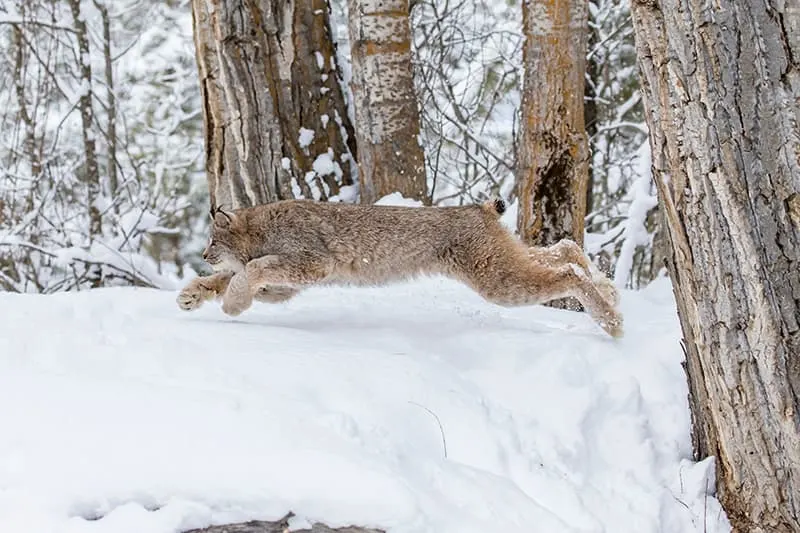
Predators
Predators that hunt juvenile bobcats are foxes, coyotes, and owls. Humans are the only predators of adult bobcats. Bobcats are hunted for their fur as well as for sport. Bobcats are sometimes killed because they prey on livestock. The bobcat population is thriving because it is adaptable. Bobcats are listed as “Least Concern” on the IUCN Red List.
Lifespan
In the wild, bobcats can live for five to fifteen years. The average lifespan of a bobcat is seven years. Bobcats usually live from twenty to twenty-five years in captivity.
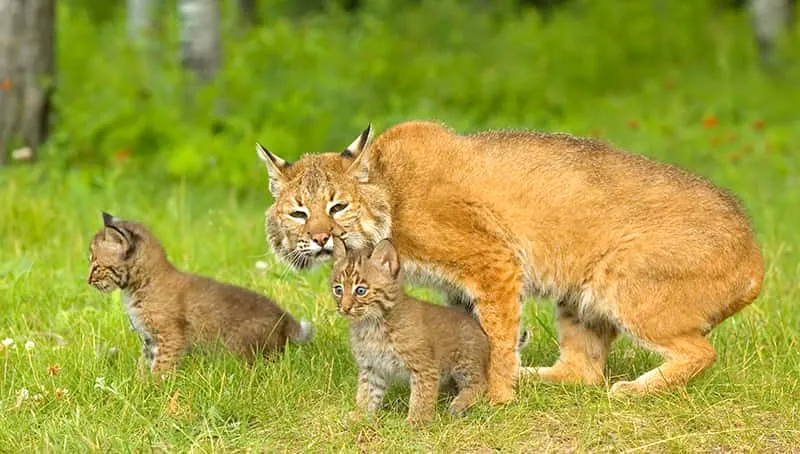
What Sound Does a Bobcat Make?
Click on this audio file to hear what a bobcat sounds like.
25+ Fascinating Facts
- The bobcat got its name because its tail is shorter than the tails of most cats.
- The bobcat is also known as a “bobtailed cat” or a “wildcat”.
- When a bobcat and a Canadian lynx mate, their kittens are known as “blynx.”
- Bobcats may have been kept as pets by people of the Hopewell Culture.
- The name “Bobcats” is the 26th most popular high-school sports team name.
- Bobcats are the smallest type of lynx.
- Bobcats will often use an abandoned den of another animal.
- Bobcats can run short distances at speeds of up to 30 miles per hour.
- Bobcats and housecats will mate sometimes.
- Bobcats can pounce from 10 feet.
- Bobcats typically fight only when they are competing for a female.
- Baby bobcats are sometimes called “bobkittens.”
- Female bobcats are called “queens.”
- Male bobcats are called “toms.”
- A group of bobcats is called “a clowder, a clutter, or a pounce.”
- Male bobcats are fully mature at 1 1/2 years old.
- Female bobcats are fully mature at 2 years old.
- Bobcats are seldom seen in the wild.
- Juvenile bobcats can travel up to 100 miles in search of new territory.
- Bobcats are good at climbing trees but spend little time in them.
- Bobcats enjoy the water and are great swimmers.
- The tip of a bobcat’s tail is black and white. The tail of a Canadian lynx is black-tipped.
- Bobcats have the widest range of any North American cat species.
- Bobcats mate with domestic cats, but they don’t have kittens.
- Bobcats are bigger in the northern part of the North American continent then they are in the southern part of the continent.
We hope you enjoyed learning all about bobcats! Did you discover any new facts? Let us know what other interesting facts you know about bobcats. We can’t wait to hear from you!
Here are some other fun mammals that you might want to learn about.

Lynx Facts for Kids - The Facts Vault
Thursday 2nd of June 2022
[…] are four species of lynx. The Bobcat, the Canadian lynx, the Eurasian lynx, and the Iberian […]